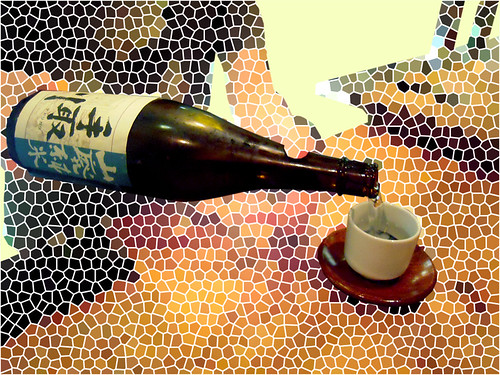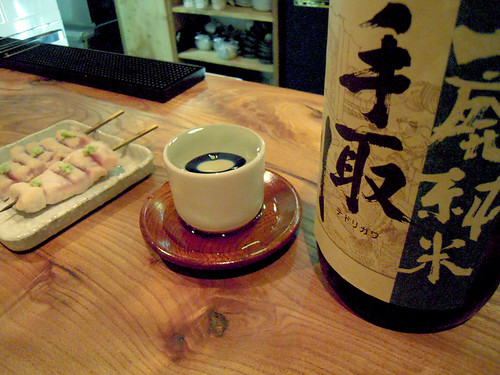Japanify: Futsushu vs. Tokutei Meishoshu (Ordinary vs. Premium Sake)

I had many opportunities during my first six months living in Japan to get really unpleasant hangovers from sake. This was mainly because I was living off a wage that made me think "Did I miss my stop and end up in China?" while drinking a lot of cheap sake. Nevertheless, the job was awesome--I worked at Design Festa in Ura-Harajuku and drank my poor-girl troubles away with co-workers at the nearby AM/PM nearly every night.
That's when I started drinking my way into the complex world of nihonshu (sake). Sake means "alcohol" in Japanese and their word for the English term "sake" is nihonshu (Nihon = Japan; Shu = Alcohol).
What constitutes the classification of futsushu (ordinary sake) versus tokutei meishoshu (premium sake) is its seimaibuai (rice polishing ratio). When preparing rice for the sake-brewing process, the rice must be polished down. This is because the outer layers with fats and oils that would otherwise disturb the taste of the sake should be eliminated. There is no set ratio for futsushu, but tokutei meishoshu (premium sake) must use rice that has been polished down at least 30% for a seimaibuai of 70% or less.
FUTSUSHU
The sake I drank out of paper cartons* during my AM/PM conbini (convenience store) days are considered futsushu (Futsu = Ordinary; Shu = Alcohol). The sake market is comprised of about 70-75% futsushu. Futsushu is like the Charles Shaw of sake--it is affordable, fairly good, ideal for cooking and may give you a horrible hangover the next day if you drink too much.
Most people in the states encounter futsushu at cheaper sushi places that serve their sake really hot. And more often than not the sake is dispensed out of an apparatus which allows the sake bottle to be cradled upside down for easy serving.
Looser restrictions on futsushu means that a larger amount of brewer's alcohol along with sugars and organic acids can be added to pump up the yeild.
Here is a futsushu brand I remember, MARU, from my poor-girl days.
http://www.youtube.com/watch?v=dabweerwaxY
*Junmai (rice sake with no distilled alcohol added) and other premium sakes are packaged in paper cartons as well, so it can't be assumed that all sake packaged in paper cartons are of ordinary grade.
TOKUTEI MEISHOSHU
Chances are that many people reading are way beyond this discussion and are only concerned with tokutei meishoshu (premium sake) which includes Junmai, Honjozo, Ginjo and Daiginjo--the kinds of sake that you would encounter in more upscale restaurants and bars. But before I dive into the descriptions for each of these (which I will next week, but for now, check out this chart on Wiki for some clarification), I feel it is necessary to define tokutei meishoshu as a whole.
As mentioned in the futsushu section, what distinguishes ordinary from premium sake is the rice polishing ratio. Premium sake must use rice that has been polished down to at least 70% its original size. This requirement results in premium sake having a smoother taste with less roughness that sometimes resides in the outer layers of the rice.
It's difficult and impossible to describe the taste characteristics of tokutei meishoshu as a whole since the range is extremely wide. But on a menu or on the shelves, the best indicator of how any tokutei meishoshu distinguishes itself from futsushu is its price. So keep your eyes peeled on the dollar sign.
I went to IPPUKU in Berkeley last night to try an example of a tokutei meishoshu and here's what I got. FYI, IPPUKU does not carry any futsushu.
Tedorigawa Yamahai Junmai Sake.

This example of tokutei meishoshu happens to be a junmai sake. Tedorigawa, with a seimaibuai of 60% and alcohol content of 15.8% was bold and smooth. IPPUKU's bartender Washi describes it as, "A chardonnay with umami." Indeed, there was a depth in the Tedorigawa that was absent from my second order, the Chikurin Fukawari (another junmai).
LESSON SUMMARY FOR FUTSUSHU VS. TOKUTEI MEISHOSHU
The following is a chart that includes some generalizations so please understand that it is possible to enjoy a wonderful futsushu, chilled. It's always smart and amusing to read the labels and see what the manufacturer recommends. But ultimately, it's all you, so taste pensively and deliberate with you and your drinking buds.
| Type of Sake | Futsushu | Tokutei meishoshu |
| English | Ordinary | Premium |
| Seimaibuai | No restriction | at least 70% |
| Temperature | Hot (with exceptions) | Chilled, room temp, hot |
| Ideal for | Cooking, drinking | Drinking |
| % of sake market | approx. 75% | appox. 20-25% |
| Other | Affordable | High quality |
This lesson continues next week when we break down the different categories within tokutei meishoshu.
